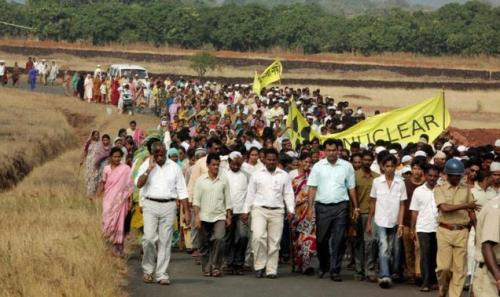The Fukushima disaster has highlighted the fact that insecurity is inherent to nuclear energy. It is quite simply not possible to predict all the technical or human malfunctions or the outbursts of nature.
This disaster, of a magnitude unequalled since Chernobyl and the extent of whose consequences is still not known, has reopened in India the debate on the safety of civil nuclear power and the Indian government’s policy of nuclear expansion.
In 2010, the share of nuclear power only represented 4,780 megawatts or 4.2% of the country’s energy consumption. The Indian government plans to multiply this capacity fivefold over the next 10 years. The constructions underway should only add 3,900 MW, but the objective fixed is to build new reactors which would cumulate in a power of 63,000 MW by 2032. That would represent 100 billion Euros of potential investment and 25% of the country’s energy.
Indeed, the revelations on the negligence in the area of safety by industrialists in the name of the race for profits illustrate the impossibility of ensuring satisfactory safety levels for nuclear installations. India does not possess an independent safety authority. The atomic energy regulation commission, which is responsible for this question, shares its personnel with and provides funds to the organisations it is supposed to control.
And yet seven power stations are being built and at least 36 new ones are being designed or planned. The government has signed an agreement with the French company AREVA to build 6 reactors of the EPR type of a total power of 3,600 megawatts in Jaitapur, a coastal town in the state of Maharashtra. Ultimately, Jaitapur will host the biggest nuclear complex in the world!
The region of Jaitapur is well known for its great biodiversity. It shelters thousands of animal and plant species of which some are threatened with extinction. The construction of the nuclear power station is a threat to this entire ecosystem. The inhabitants of the region, some of whom have been expropriated, have reacted strongly against this nuclear power station project which threatens their way of life and the environment.
The Indian government has responded to the opposition with the greatest scorn. Demonstrations have been harshly repressed and a demonstrator killed. Jaitapur illustrates the blindness of the nucleocrats. To this day, no EPR reactor has yet been tested. Outside of the prototype of Flamanville, one is being built in Finland, two at a more initial stage in China. The Finnish project is now two years late. It should cost 3 billion Euros but its cost has now reached 5 to 7 billion, a financial abyss paid for by the French taxpayer.
If we refer to the Fukushima disaster, the choice of Jaitapur is an aberration. Located on the coast, the site is not sheltered from sea water infiltration or a tsunami and Jaitapur has already been hit by an earthquake. Also, India is not Japan. No evacuation plan exists in case of accident in a power station. What would happen if a nuclear disaster affected the country?
The Coalition for Nuclear Disarmament and Peace (CDNP), involving 200 Indian associations, calls for a moratorium on Indian civil nuclear activities and an audit on the installations in service. Greenpeace India has launched an online petition seeking to gather 100,000 signatures against the construction of the six reactors at Jaitapur.
With the Fukushima disaster, the opposition has deepened. It is important to support the mobilisations against the dizzying nuclear expansion envisaged by the Indian government. There is a risk of seeing a new disaster, which we can imagine will be still more destructive and costly in human life, and quite simply unbearable. Everything must be done to stop this new nuclear folly.
Petition against the construction of the nuclear power station at Jaitapur
Translated from French for IVP

No comments:
Post a Comment